University Report: Fructose-1, 6-Bisphosphatase Deficiency and Health
VerifiedAdded on 2022/11/17
|7
|1527
|107
Report
AI Summary
This report delves into Fructose-1, 6-bisphosphatase deficiency, a metabolic disorder characterized by the body's inability to produce glucose due to a deficiency in the Fructose-1, 6-bisphosphatase enzyme. The report outlines the enzyme's structure, function, and its role in gluconeogenesis and the Calvin cycle. It discusses the biochemical pathways affected, including the regulation of glucose sensing and insulin secretion. The report further explores the genetic aspects, inheritance patterns, and symptoms like hypoglycemia and metabolic acidosis. Treatment strategies, such as avoiding fructose and prolonged fasting, are examined, along with relevant policies like the Australian National Diabetes Strategy. Recent research and diagnostic methods are also included, providing a comprehensive overview of the disorder and its management. The report concludes by emphasizing the importance of the enzyme in regulating blood glucose levels and preventing metabolic acidosis. This report is available on Desklib, a platform providing AI-based study tools and past papers for students.
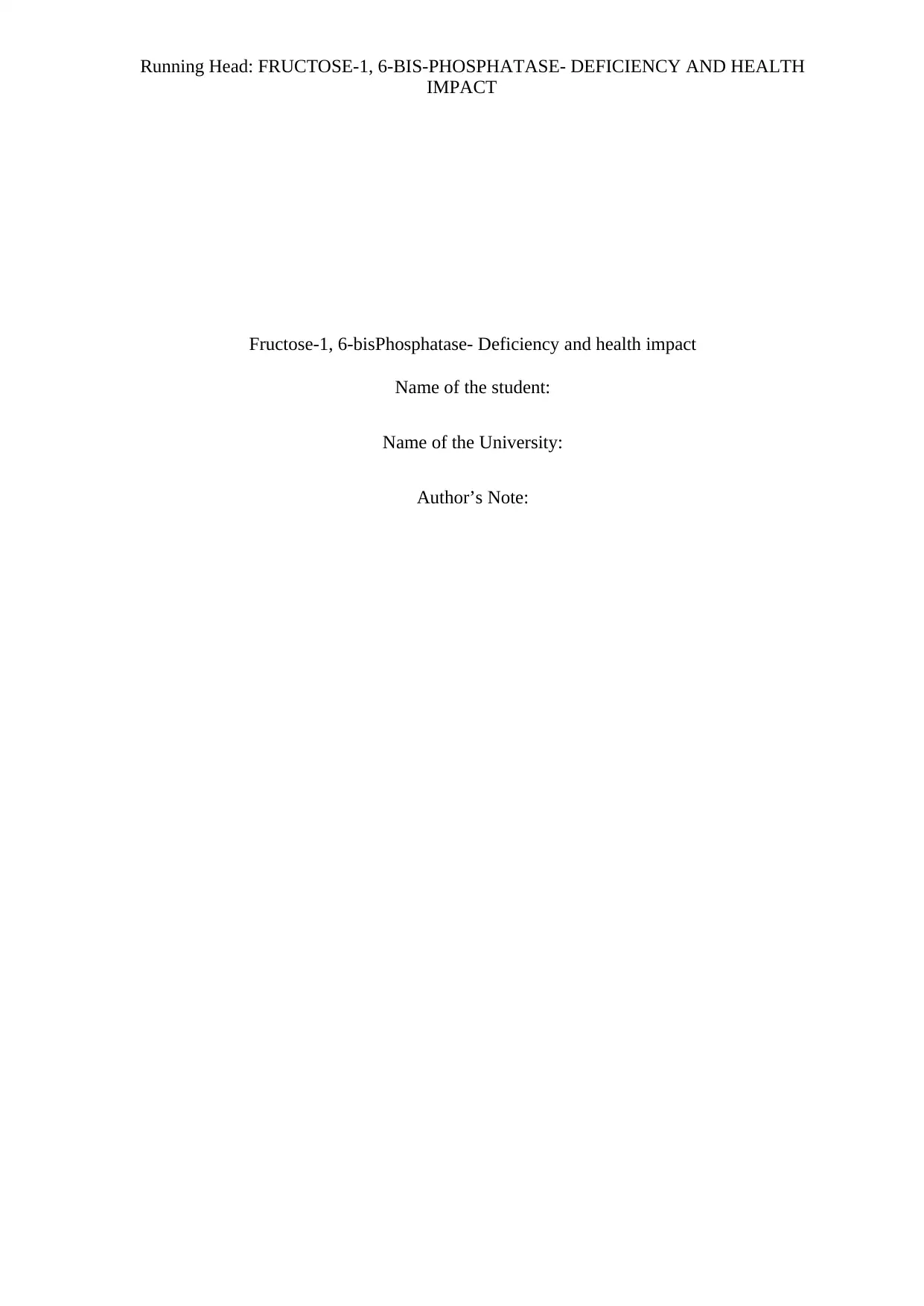
Running Head: FRUCTOSE-1, 6-BIS-PHOSPHATASE- DEFICIENCY AND HEALTH
IMPACT
Fructose-1, 6-bisPhosphatase- Deficiency and health impact
Name of the student:
Name of the University:
Author’s Note:
IMPACT
Fructose-1, 6-bisPhosphatase- Deficiency and health impact
Name of the student:
Name of the University:
Author’s Note:
Paraphrase This Document
Need a fresh take? Get an instant paraphrase of this document with our AI Paraphraser
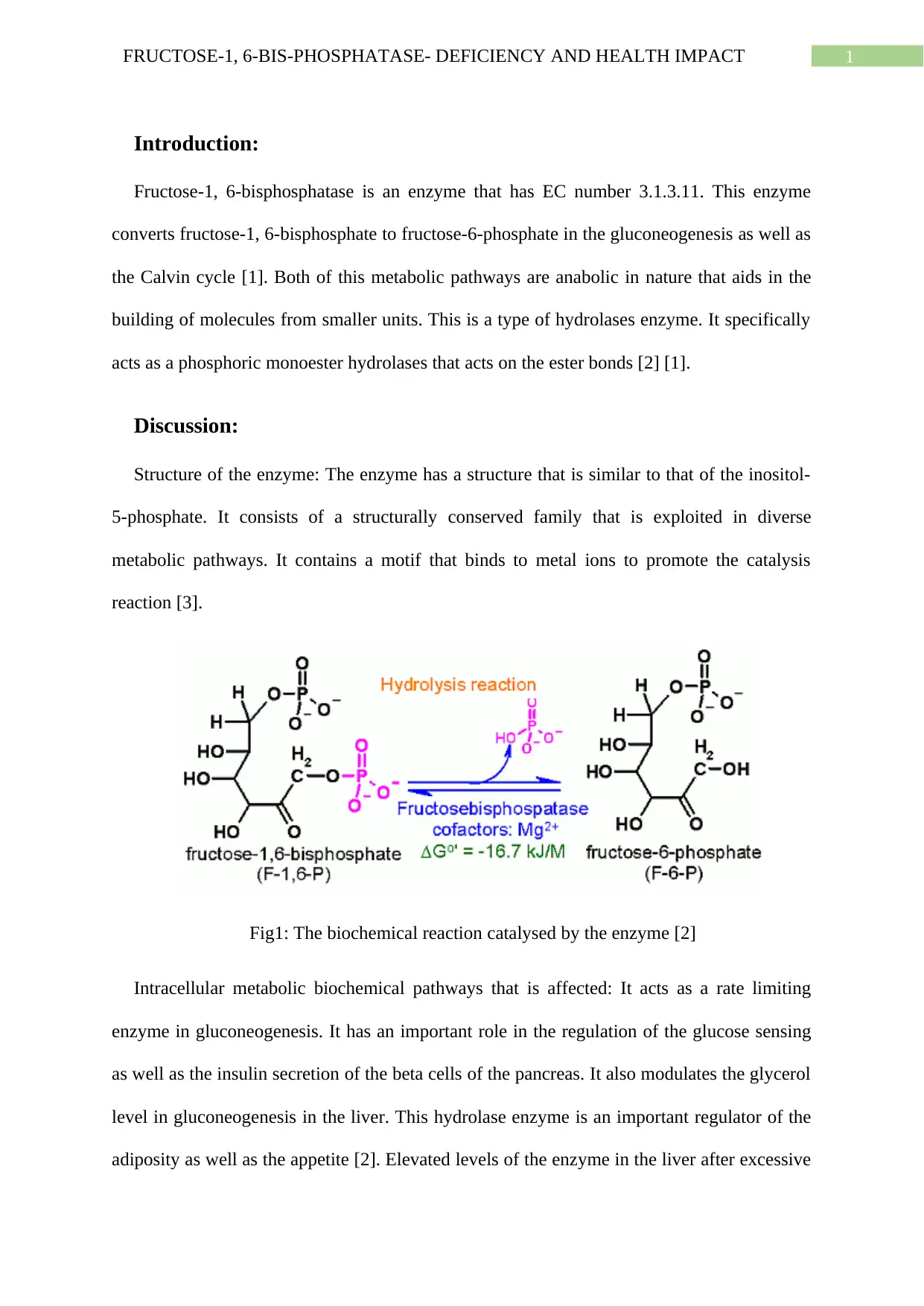
1FRUCTOSE-1, 6-BIS-PHOSPHATASE- DEFICIENCY AND HEALTH IMPACT
Introduction:
Fructose-1, 6-bisphosphatase is an enzyme that has EC number 3.1.3.11. This enzyme
converts fructose-1, 6-bisphosphate to fructose-6-phosphate in the gluconeogenesis as well as
the Calvin cycle [1]. Both of this metabolic pathways are anabolic in nature that aids in the
building of molecules from smaller units. This is a type of hydrolases enzyme. It specifically
acts as a phosphoric monoester hydrolases that acts on the ester bonds [2] [1].
Discussion:
Structure of the enzyme: The enzyme has a structure that is similar to that of the inositol-
5-phosphate. It consists of a structurally conserved family that is exploited in diverse
metabolic pathways. It contains a motif that binds to metal ions to promote the catalysis
reaction [3].
Fig1: The biochemical reaction catalysed by the enzyme [2]
Intracellular metabolic biochemical pathways that is affected: It acts as a rate limiting
enzyme in gluconeogenesis. It has an important role in the regulation of the glucose sensing
as well as the insulin secretion of the beta cells of the pancreas. It also modulates the glycerol
level in gluconeogenesis in the liver. This hydrolase enzyme is an important regulator of the
adiposity as well as the appetite [2]. Elevated levels of the enzyme in the liver after excessive
Introduction:
Fructose-1, 6-bisphosphatase is an enzyme that has EC number 3.1.3.11. This enzyme
converts fructose-1, 6-bisphosphate to fructose-6-phosphate in the gluconeogenesis as well as
the Calvin cycle [1]. Both of this metabolic pathways are anabolic in nature that aids in the
building of molecules from smaller units. This is a type of hydrolases enzyme. It specifically
acts as a phosphoric monoester hydrolases that acts on the ester bonds [2] [1].
Discussion:
Structure of the enzyme: The enzyme has a structure that is similar to that of the inositol-
5-phosphate. It consists of a structurally conserved family that is exploited in diverse
metabolic pathways. It contains a motif that binds to metal ions to promote the catalysis
reaction [3].
Fig1: The biochemical reaction catalysed by the enzyme [2]
Intracellular metabolic biochemical pathways that is affected: It acts as a rate limiting
enzyme in gluconeogenesis. It has an important role in the regulation of the glucose sensing
as well as the insulin secretion of the beta cells of the pancreas. It also modulates the glycerol
level in gluconeogenesis in the liver. This hydrolase enzyme is an important regulator of the
adiposity as well as the appetite [2]. Elevated levels of the enzyme in the liver after excessive
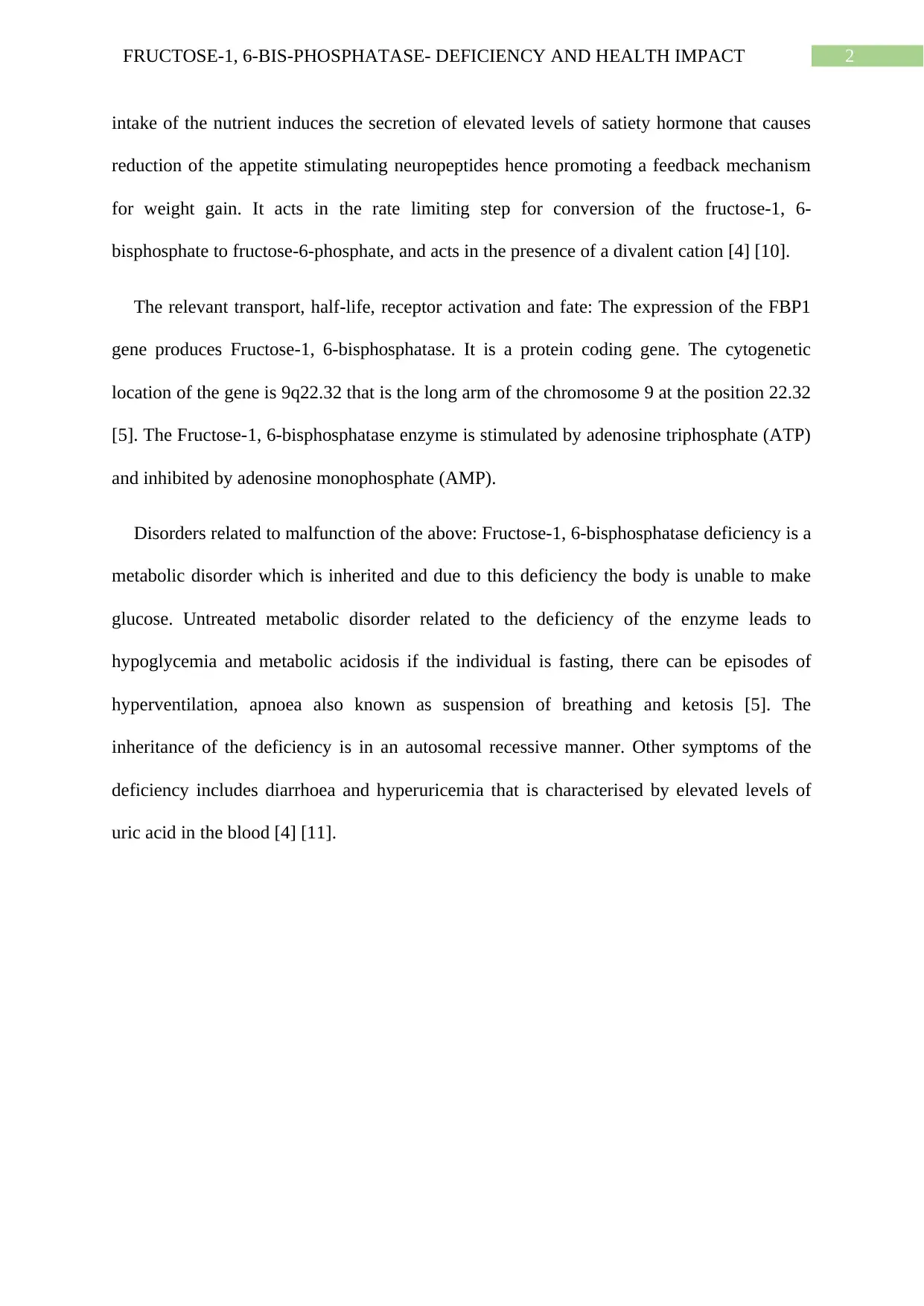
2FRUCTOSE-1, 6-BIS-PHOSPHATASE- DEFICIENCY AND HEALTH IMPACT
intake of the nutrient induces the secretion of elevated levels of satiety hormone that causes
reduction of the appetite stimulating neuropeptides hence promoting a feedback mechanism
for weight gain. It acts in the rate limiting step for conversion of the fructose-1, 6-
bisphosphate to fructose-6-phosphate, and acts in the presence of a divalent cation [4] [10].
The relevant transport, half-life, receptor activation and fate: The expression of the FBP1
gene produces Fructose-1, 6-bisphosphatase. It is a protein coding gene. The cytogenetic
location of the gene is 9q22.32 that is the long arm of the chromosome 9 at the position 22.32
[5]. The Fructose-1, 6-bisphosphatase enzyme is stimulated by adenosine triphosphate (ATP)
and inhibited by adenosine monophosphate (AMP).
Disorders related to malfunction of the above: Fructose-1, 6-bisphosphatase deficiency is a
metabolic disorder which is inherited and due to this deficiency the body is unable to make
glucose. Untreated metabolic disorder related to the deficiency of the enzyme leads to
hypoglycemia and metabolic acidosis if the individual is fasting, there can be episodes of
hyperventilation, apnoea also known as suspension of breathing and ketosis [5]. The
inheritance of the deficiency is in an autosomal recessive manner. Other symptoms of the
deficiency includes diarrhoea and hyperuricemia that is characterised by elevated levels of
uric acid in the blood [4] [11].
intake of the nutrient induces the secretion of elevated levels of satiety hormone that causes
reduction of the appetite stimulating neuropeptides hence promoting a feedback mechanism
for weight gain. It acts in the rate limiting step for conversion of the fructose-1, 6-
bisphosphate to fructose-6-phosphate, and acts in the presence of a divalent cation [4] [10].
The relevant transport, half-life, receptor activation and fate: The expression of the FBP1
gene produces Fructose-1, 6-bisphosphatase. It is a protein coding gene. The cytogenetic
location of the gene is 9q22.32 that is the long arm of the chromosome 9 at the position 22.32
[5]. The Fructose-1, 6-bisphosphatase enzyme is stimulated by adenosine triphosphate (ATP)
and inhibited by adenosine monophosphate (AMP).
Disorders related to malfunction of the above: Fructose-1, 6-bisphosphatase deficiency is a
metabolic disorder which is inherited and due to this deficiency the body is unable to make
glucose. Untreated metabolic disorder related to the deficiency of the enzyme leads to
hypoglycemia and metabolic acidosis if the individual is fasting, there can be episodes of
hyperventilation, apnoea also known as suspension of breathing and ketosis [5]. The
inheritance of the deficiency is in an autosomal recessive manner. Other symptoms of the
deficiency includes diarrhoea and hyperuricemia that is characterised by elevated levels of
uric acid in the blood [4] [11].
⊘ This is a preview!⊘
Do you want full access?
Subscribe today to unlock all pages.

Trusted by 1+ million students worldwide
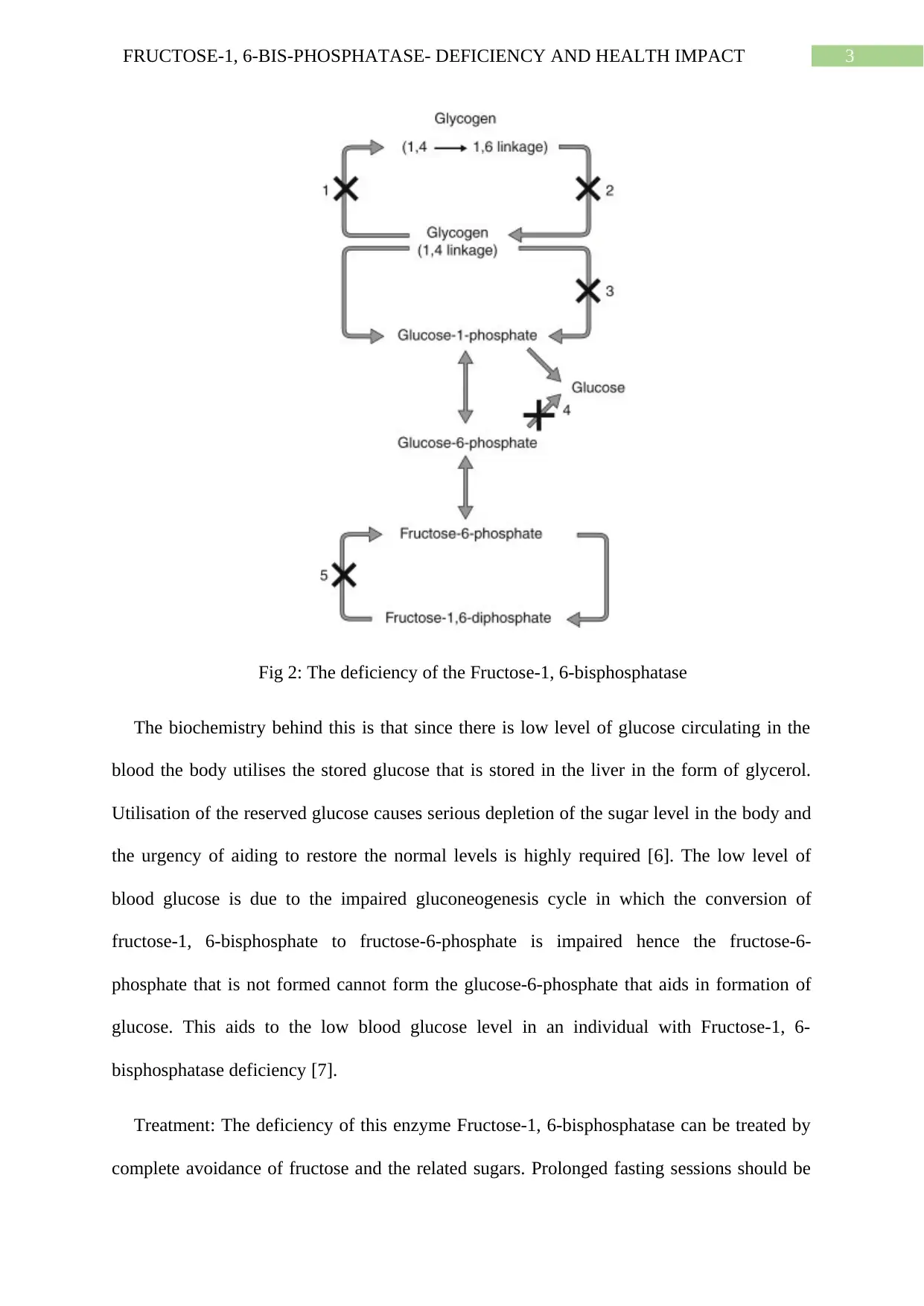
3FRUCTOSE-1, 6-BIS-PHOSPHATASE- DEFICIENCY AND HEALTH IMPACT
Fig 2: The deficiency of the Fructose-1, 6-bisphosphatase
The biochemistry behind this is that since there is low level of glucose circulating in the
blood the body utilises the stored glucose that is stored in the liver in the form of glycerol.
Utilisation of the reserved glucose causes serious depletion of the sugar level in the body and
the urgency of aiding to restore the normal levels is highly required [6]. The low level of
blood glucose is due to the impaired gluconeogenesis cycle in which the conversion of
fructose-1, 6-bisphosphate to fructose-6-phosphate is impaired hence the fructose-6-
phosphate that is not formed cannot form the glucose-6-phosphate that aids in formation of
glucose. This aids to the low blood glucose level in an individual with Fructose-1, 6-
bisphosphatase deficiency [7].
Treatment: The deficiency of this enzyme Fructose-1, 6-bisphosphatase can be treated by
complete avoidance of fructose and the related sugars. Prolonged fasting sessions should be
Fig 2: The deficiency of the Fructose-1, 6-bisphosphatase
The biochemistry behind this is that since there is low level of glucose circulating in the
blood the body utilises the stored glucose that is stored in the liver in the form of glycerol.
Utilisation of the reserved glucose causes serious depletion of the sugar level in the body and
the urgency of aiding to restore the normal levels is highly required [6]. The low level of
blood glucose is due to the impaired gluconeogenesis cycle in which the conversion of
fructose-1, 6-bisphosphate to fructose-6-phosphate is impaired hence the fructose-6-
phosphate that is not formed cannot form the glucose-6-phosphate that aids in formation of
glucose. This aids to the low blood glucose level in an individual with Fructose-1, 6-
bisphosphatase deficiency [7].
Treatment: The deficiency of this enzyme Fructose-1, 6-bisphosphatase can be treated by
complete avoidance of fructose and the related sugars. Prolonged fasting sessions should be
Paraphrase This Document
Need a fresh take? Get an instant paraphrase of this document with our AI Paraphraser

4FRUCTOSE-1, 6-BIS-PHOSPHATASE- DEFICIENCY AND HEALTH IMPACT
avoided. If this is maintained no other specific treatment is required for the treatment of this
deficiency unless the deficiency is chronic [7] [9].
Relevant policies pertinent to the disorder: The Australian National Diabetes Strategy has
the goals to outline the national response of Australia to diabetes and also educate how
existing limited health care responses can be exploited at all levels of the government by
efficient coordination. This strategy identifies the most efficacious and appropriate
interventions to combat glucose impairment among the people [8]. The policy majorly
involves educating and spreading the awareness plan in the family of the affected individual,
the blood sugar level should be regularly monitored of the affected individual at regular
intervals and if the glucose level in the blood has reduced a lot then administration of
glucagon should be encouraged.
Conclusion:
It can be concluded from this above article that fructose-1, 6-bisphosphatase is a very
essential enzyme for regulating the blood glucose level and the prevention of the metabolic
acidosis that also occurs as a consequence. Prevention of long hours of fasting and avoiding
fructose and similar sugar intakes aid in combating the enzyme deficiency syndrome that is
characterised by hypoglycemia and metabolic acidosis.
avoided. If this is maintained no other specific treatment is required for the treatment of this
deficiency unless the deficiency is chronic [7] [9].
Relevant policies pertinent to the disorder: The Australian National Diabetes Strategy has
the goals to outline the national response of Australia to diabetes and also educate how
existing limited health care responses can be exploited at all levels of the government by
efficient coordination. This strategy identifies the most efficacious and appropriate
interventions to combat glucose impairment among the people [8]. The policy majorly
involves educating and spreading the awareness plan in the family of the affected individual,
the blood sugar level should be regularly monitored of the affected individual at regular
intervals and if the glucose level in the blood has reduced a lot then administration of
glucagon should be encouraged.
Conclusion:
It can be concluded from this above article that fructose-1, 6-bisphosphatase is a very
essential enzyme for regulating the blood glucose level and the prevention of the metabolic
acidosis that also occurs as a consequence. Prevention of long hours of fasting and avoiding
fructose and similar sugar intakes aid in combating the enzyme deficiency syndrome that is
characterised by hypoglycemia and metabolic acidosis.
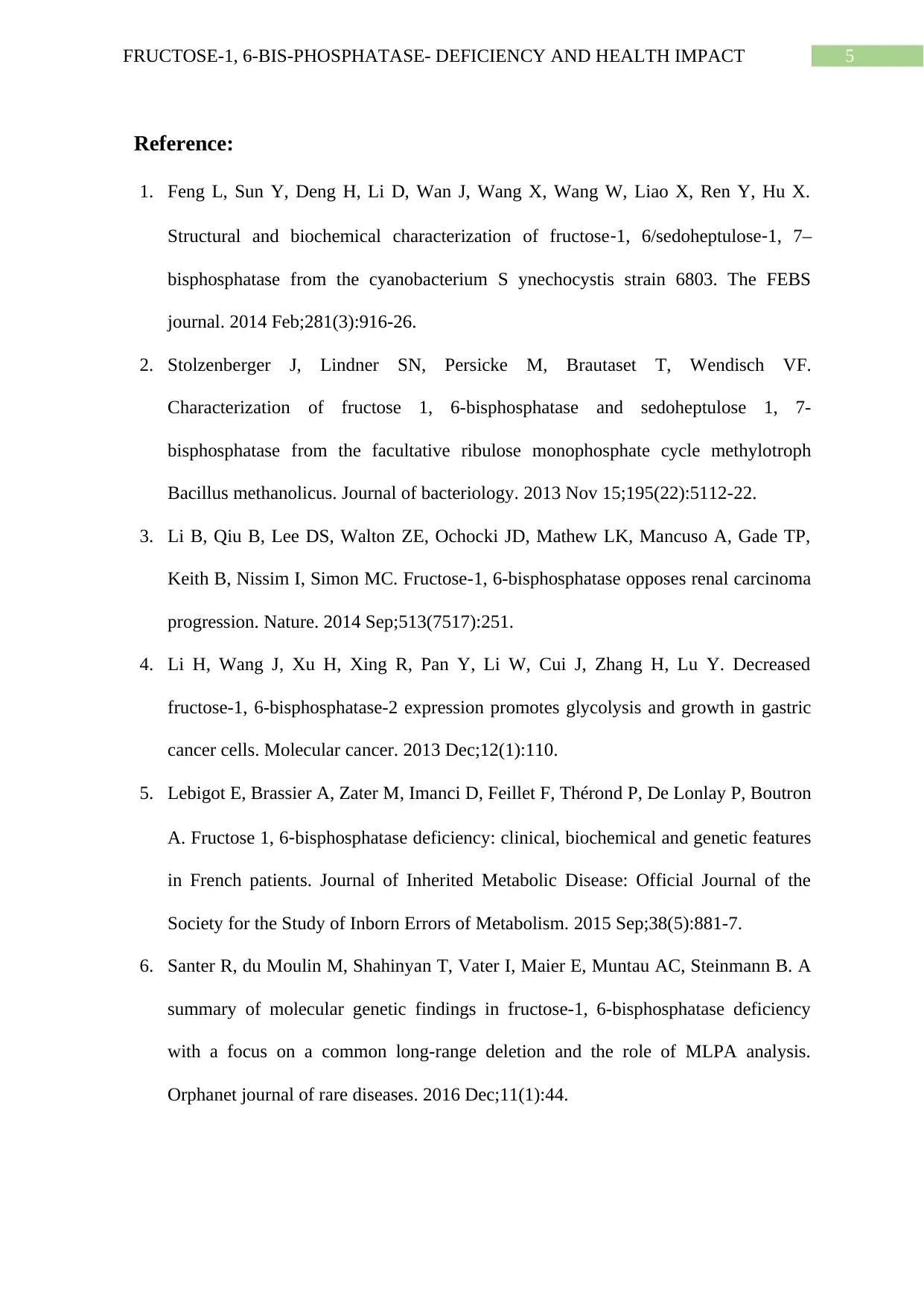
5FRUCTOSE-1, 6-BIS-PHOSPHATASE- DEFICIENCY AND HEALTH IMPACT
Reference:
1. Feng L, Sun Y, Deng H, Li D, Wan J, Wang X, Wang W, Liao X, Ren Y, Hu X.
Structural and biochemical characterization of fructose‐1, 6/sedoheptulose‐1, 7–
bisphosphatase from the cyanobacterium S ynechocystis strain 6803. The FEBS
journal. 2014 Feb;281(3):916-26.
2. Stolzenberger J, Lindner SN, Persicke M, Brautaset T, Wendisch VF.
Characterization of fructose 1, 6-bisphosphatase and sedoheptulose 1, 7-
bisphosphatase from the facultative ribulose monophosphate cycle methylotroph
Bacillus methanolicus. Journal of bacteriology. 2013 Nov 15;195(22):5112-22.
3. Li B, Qiu B, Lee DS, Walton ZE, Ochocki JD, Mathew LK, Mancuso A, Gade TP,
Keith B, Nissim I, Simon MC. Fructose-1, 6-bisphosphatase opposes renal carcinoma
progression. Nature. 2014 Sep;513(7517):251.
4. Li H, Wang J, Xu H, Xing R, Pan Y, Li W, Cui J, Zhang H, Lu Y. Decreased
fructose-1, 6-bisphosphatase-2 expression promotes glycolysis and growth in gastric
cancer cells. Molecular cancer. 2013 Dec;12(1):110.
5. Lebigot E, Brassier A, Zater M, Imanci D, Feillet F, Thérond P, De Lonlay P, Boutron
A. Fructose 1, 6‐bisphosphatase deficiency: clinical, biochemical and genetic features
in French patients. Journal of Inherited Metabolic Disease: Official Journal of the
Society for the Study of Inborn Errors of Metabolism. 2015 Sep;38(5):881-7.
6. Santer R, du Moulin M, Shahinyan T, Vater I, Maier E, Muntau AC, Steinmann B. A
summary of molecular genetic findings in fructose-1, 6-bisphosphatase deficiency
with a focus on a common long-range deletion and the role of MLPA analysis.
Orphanet journal of rare diseases. 2016 Dec;11(1):44.
Reference:
1. Feng L, Sun Y, Deng H, Li D, Wan J, Wang X, Wang W, Liao X, Ren Y, Hu X.
Structural and biochemical characterization of fructose‐1, 6/sedoheptulose‐1, 7–
bisphosphatase from the cyanobacterium S ynechocystis strain 6803. The FEBS
journal. 2014 Feb;281(3):916-26.
2. Stolzenberger J, Lindner SN, Persicke M, Brautaset T, Wendisch VF.
Characterization of fructose 1, 6-bisphosphatase and sedoheptulose 1, 7-
bisphosphatase from the facultative ribulose monophosphate cycle methylotroph
Bacillus methanolicus. Journal of bacteriology. 2013 Nov 15;195(22):5112-22.
3. Li B, Qiu B, Lee DS, Walton ZE, Ochocki JD, Mathew LK, Mancuso A, Gade TP,
Keith B, Nissim I, Simon MC. Fructose-1, 6-bisphosphatase opposes renal carcinoma
progression. Nature. 2014 Sep;513(7517):251.
4. Li H, Wang J, Xu H, Xing R, Pan Y, Li W, Cui J, Zhang H, Lu Y. Decreased
fructose-1, 6-bisphosphatase-2 expression promotes glycolysis and growth in gastric
cancer cells. Molecular cancer. 2013 Dec;12(1):110.
5. Lebigot E, Brassier A, Zater M, Imanci D, Feillet F, Thérond P, De Lonlay P, Boutron
A. Fructose 1, 6‐bisphosphatase deficiency: clinical, biochemical and genetic features
in French patients. Journal of Inherited Metabolic Disease: Official Journal of the
Society for the Study of Inborn Errors of Metabolism. 2015 Sep;38(5):881-7.
6. Santer R, du Moulin M, Shahinyan T, Vater I, Maier E, Muntau AC, Steinmann B. A
summary of molecular genetic findings in fructose-1, 6-bisphosphatase deficiency
with a focus on a common long-range deletion and the role of MLPA analysis.
Orphanet journal of rare diseases. 2016 Dec;11(1):44.
⊘ This is a preview!⊘
Do you want full access?
Subscribe today to unlock all pages.

Trusted by 1+ million students worldwide

6FRUCTOSE-1, 6-BIS-PHOSPHATASE- DEFICIENCY AND HEALTH IMPACT
7. Sugita G, Tsuyoshi H, Nishijima K, Yoshida Y. Fructose-1, 6-bisphosphatase
deficiency: a case of a successful pregnancy by closely monitoring metabolic control.
InJIMD Reports, Volume 14 2014 (pp. 115-118). Springer, Berlin, Heidelberg.
8. Santer R, du Moulin M, Shahinyan T, Vater I, Maier E, Muntau AC, Steinmann B. A
summary of molecular genetic findings in fructose-1, 6-bisphosphatase deficiency
with a focus on a common long-range deletion and the role of MLPA analysis.
Orphanet journal of rare diseases. 2016 Dec;11(1):44.
9. Li N, Chang G, Xu Y, Ding Y, Li G, Yu T, Qing Y, Li J, Shen Y, Wang J, Wang X.
Clinical and molecular characterization of patients with fructose 1, 6-bisphosphatase
deficiency. International journal of molecular sciences. 2017 Apr;18(4):857.
10. Ioannidis I. Diabetes treatment in patients with renal disease: Is the landscape clear
enough?. World journal of diabetes. 2014 Oct 15;5(5):651.
11. Johnson PC, Vaduganathan M, Phillips KM, O'Donnell WJ. A triad of linezolid
toxicity: hypoglycemia, lactic acidosis, and acute pancreatitis. InBaylor University
Medical Center Proceedings 2015 Oct 1 (Vol. 28, No. 4, pp. 466-468). Taylor &
Francis.
7. Sugita G, Tsuyoshi H, Nishijima K, Yoshida Y. Fructose-1, 6-bisphosphatase
deficiency: a case of a successful pregnancy by closely monitoring metabolic control.
InJIMD Reports, Volume 14 2014 (pp. 115-118). Springer, Berlin, Heidelberg.
8. Santer R, du Moulin M, Shahinyan T, Vater I, Maier E, Muntau AC, Steinmann B. A
summary of molecular genetic findings in fructose-1, 6-bisphosphatase deficiency
with a focus on a common long-range deletion and the role of MLPA analysis.
Orphanet journal of rare diseases. 2016 Dec;11(1):44.
9. Li N, Chang G, Xu Y, Ding Y, Li G, Yu T, Qing Y, Li J, Shen Y, Wang J, Wang X.
Clinical and molecular characterization of patients with fructose 1, 6-bisphosphatase
deficiency. International journal of molecular sciences. 2017 Apr;18(4):857.
10. Ioannidis I. Diabetes treatment in patients with renal disease: Is the landscape clear
enough?. World journal of diabetes. 2014 Oct 15;5(5):651.
11. Johnson PC, Vaduganathan M, Phillips KM, O'Donnell WJ. A triad of linezolid
toxicity: hypoglycemia, lactic acidosis, and acute pancreatitis. InBaylor University
Medical Center Proceedings 2015 Oct 1 (Vol. 28, No. 4, pp. 466-468). Taylor &
Francis.
1 out of 7
Related Documents
Your All-in-One AI-Powered Toolkit for Academic Success.
+13062052269
info@desklib.com
Available 24*7 on WhatsApp / Email
![[object Object]](/_next/static/media/star-bottom.7253800d.svg)
Unlock your academic potential
Copyright © 2020–2025 A2Z Services. All Rights Reserved. Developed and managed by ZUCOL.




